Personalized mitts prove 'it's all about showing style and personality' in modern baseball
Baseball gloves are more than just pieces of equipment as athletes express themselves through color, imagery

When Willie Mays made his famous over-the-shoulder catch in the 1954 World Series, few noticed the glove he used to make the play.
After all, there seemed to be only three kinds of mitts at the time: one for catchers, one for first basemen and another for everyone else in the field, all in brown or black.
Players thought so little of their gloves that until 1954 - that's right, the year of Mays' immortal catch - they would leave their mitts on the field. Catchers and pitchers casually tossed their gloves on dugout roofs.
Today, baseball gloves are treated with a little more respect. No longer just a leather appendage to protect the non-throwing hand from harm and to snag line drives and gobble up ground balls, the glove reflects a players artistic sensibility and personality. No longer does one size or color fit all.
With the help of all major glove manufacturers, players have transformed that old brown hunk of leather into a technicolor fashion accessory that also works as, well, a baseball glove.
Custom-fitted, hand-molded and brightly dyed leather have sent the old ill-fitting Charlie Brown model to the thrift shop for good.
Mike Carozza, the founder of WhatProsWear, a website that chronicles gloves and other gear of major leaguers, said for him the glove industry's move to fashion started with Ken Griffey Jr., the Hall of Fame centerfielder of the Seattle Mariners. It’s a big reason that he started his website.
“I was down in spring training the other day and I'm seeing more Griffey jerseys than anybody else, he goes beyond the game,” Carozza said. “Meanwhile his most iconic piece, of course, the cleats, too, but his glove, like I can't find any information. I got money in my hand, and I can't find this glove.”
Carozza finally found the glove in 2007.
He saw the Ken Griffey Jr. Rawlings PRO TB-24 as a work of art. The black leather shell held together with brown laces and featuring the trap-eze web, a design finished with the slugger's signature not in the center of the mitt but stitched on the thumb.
“I think it's the most beautiful glove ever made,” Carozza said. “I'm just partial to it.”
Griffey stood at the time as the birth of the cool in baseball. His cap turned backwards, the Nike Air Griffey cleats and chill approach to an uptight sport signaled a new era in the old game.
Griffey is now in his 50s and long retired from the game, but what he started is far from finishing. Personality matters for all players - and the size of the contracts they sign.
Major League Baseball has few restrictions on gloves, generally just barring the use of white or gray as the dominant color of the mitts pitchers wear.
The MLB rule states that, “the pitcher’s glove may not, exclusive of piping, be white or gray.”
Umpires, who determines whether the glove is blending in with the ball, enforce the rule. They can order a pitcher to switch mitts if it does.
The important piece to note is that there are no restrictions of glove color for any of the other positions. That means players can create their version of art on leather.
Seven-time all-star Billy Wagner played between 1995 and 2010. He wishes he could have customized his gear as players do today.
“We all wanted to, but it was all structured different,” Wagner said. “If you wear your pants baggy, you got fined… I mean there was fun in the game, but you couldn't do as much color, you couldn't be as outgoing. So how the game has evolved now, I love the color, I love that you can be a little bit more flamboyant in your personality.”
For Wagner, he had the double whammy.
He played in an era with more restrictions on displays of personality - a batter would not show up a pitcher unless he wanted to get drilled with a fastball to the ribs in the next at bat. Pitchers had limited choices on gloves.
Now, players celebrate home runs before leaving the batter's box and are encouraged by glove companies to embrace designer gloves.
Marucci and Rawlings
Two companies in particular, Marucci and Rawlings, are leading innovators of glove showmanship.
Marucci, which started in 2004 as a bat manufacturer based on Baton Rouge, Louisiana, is a baby compared to Rawlings, which traces its linage to 1887. It added a design team headed by Eric Walbridge, known as The Glove Cowboy, in 2018.
The former college baseball player worked at Easton before coming over to Marucci, where he is the vice president of soft goods, ball gloves, batting gloves and bags.
If you see Walbridge, he is most likely decked out in some sort of streetwear. He has pierced ears and prefers to wear chains. All style, no cowboy, in that get up. Still, he is a cowboy, at least of gloves.
The nickname originates from some bedsheets he had while he was staying at his now wife’s parents’ house. Walbridge had a twin bed and instead of purchasing new sheets, he asked if his mother could send some of his old ones to him.
“She sent me these cowboy printed bed sheets, where it was like an all over pattern of a cowboy and a cactus, and a horse or something,” Walbridge said.
Walbridge’s first foray into gloves was taking photos of them for his Instagram, and where did he take those photos? His bed, with cowboys and horses frolicking in the background.
While Walbridge might not have the look of a cowboy, he is a pioneer.
Marucci has its run-of-the-mill gloves, tan, blue, red, whatever colors a player could think of, but they also have an “anti-collection” called the Nightshift.
“How do you differentiate yourself in this space, right?” Walbridge said. “I mean, we don't have 100 years of nostalgia and heritage, and our grandfather's glove that got passed down where you're building this like brand loyalty.”
As a new entrant in the glove business, as Walbridge pointed out, Marucci needed an identity apart from the traditional glove makers. Enter Nightshift.
“We need the retail pieces to support the business, right?” Walbridge said. “So, like more traditional, less polarizing things, which is like your day shift, if you will. Then at night you do the fun stuff, the hobby like when no one's looking, and that was like the night shift.”
The Nightshift is where Walbridge stretches the possibilities of gloves and his imagination, intertwining them with popular culture and fashion.
The Nightshift has released gloves based on P.F. Flyers from Sandlot, Scotty Cameron putters, multiple Nike dunk sneakers and SpongeBob SquarePants, just to name a few.
Walbridge also tries to apply this creative mentality to the gloves he customizes with players. One of the players that has a particularly out-of-the-box glove is Christopher Morel of the Chicago Cubs.
Morel’s gloves for the season look like something you would find at the end of a rainbow. Each of the mitts feature a smiley face emoji signifying his iconic smile and are covered in patterns that you would see Will Smith wearing on the Fresh Prince of Bel Air.
Morel’s gloves for the season look like something you would find at the end of a rainbow. Each of the mitts feature a smiley face emoji signifying his iconic smile and are covered in patterns that you would see Will Smith wearing on the Fresh Prince of Bel Air.
Another player that Walbridge recognizes as changing the game from a style perspective is Mr. Smile himself, Mets shortstop Francisco Lindor.
“Francisco Lindor, he’s awesome,” Walbridge said. “We don't have him in our gloves, but just as a player, he swings our bats, he's always here. He's such an awesome dude, but like what he brings is awesome. Like the personality, he always changes his hair color. That's just something that is different for baseball.”
The Puerto Rico native may not be in Marucci gloves, but he is certainly showing his personality through his mitts.
As a Rawlings-sponsored athlete, Lindor single-handedly helped design the Rawlings Rev1x. The Rev1x is a hybrid between leather and a rubber material that allows the glove to be flexible and coincidentally accommodates for sweet designs.
“We work very closely with our pros, what's working, what they like what they don't like,” said Lindsey Naber, senior director of brand marketing for Rawlings.
“Lindor wanted some more flexibility around the thumb and the pinkie, and he wanted something stable, but more nimble and something different so that he could show his own style.”
Rawlings' 19th century roots do not prevent it from catching the 21st century creative vibe. It may prefer premium leather but that didn't prevent the company from adopting synthetic materials to meet contemporary demand.
If you watch 10 Mets games, there’s a good chance that Lindor is rocking 10 different gloves. The four-time All-Star has a constant carousel of changing patterns and pictures on his Rev1X. Naber said he shows up to meetings with hand-drawn glove ideas.
“He has such a fun personality, and it's so cool to see it come into his glove design,” Naber said. “He made one for his mother. He has a New York-themed one that has a rat and a piece of pizza and a New York subway on it. So, I love that he can reflect what he's thinking and feeling and add some design elements that show his personality.”
The Rev1X has changed the glove game across MLB. Phillies outfielder Bryce Harper, famous for his Philly Phanatic themed gear, has a Phanatic Rev1X. Phillies shortstop Trea Turner designed two gloves in honor of his son Beckham for Father’s Day. The gloves are a nod to his love for trucks, one has a truck pattern and the other has a construction vehicle pattern.
“Jeff McNeil ... had one he showed me at Spring Training -- he's a big golfer, and he's a big dog lover, so he had this cool golf design and a picture of his dog on his Rev1x,” Naber said.
The Mets super utility man’s first sport was golf for most of his life, so it’s ingrained in his roots. That’s what makes the gloves special. Players put a piece of themselves into the design.
“The glove is such a personal product,” Naber said. “It's not like a wood bat, where they're switching brands all the time. It's so tied to their performance and their style and their personality, and now they're able to do so much with it. That’s really special to see how they differ from player to player.”
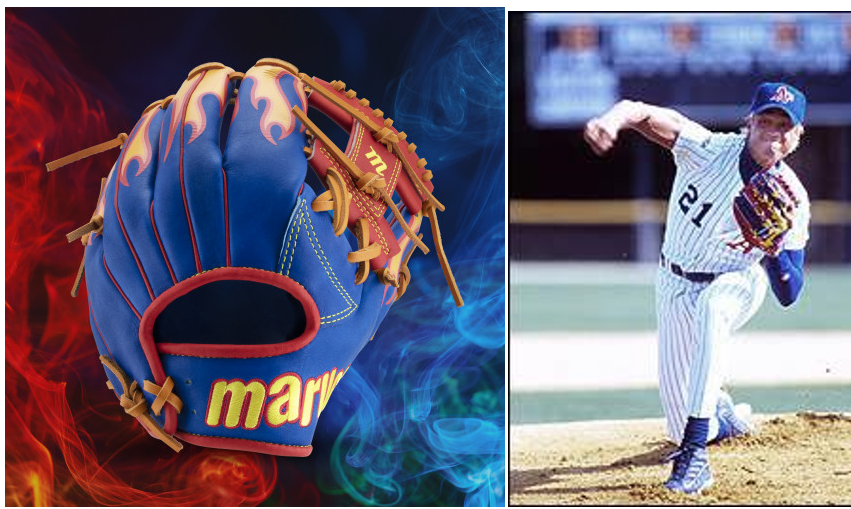
Contributed by Eric Walbridge
Contributed by Eric Walbridge
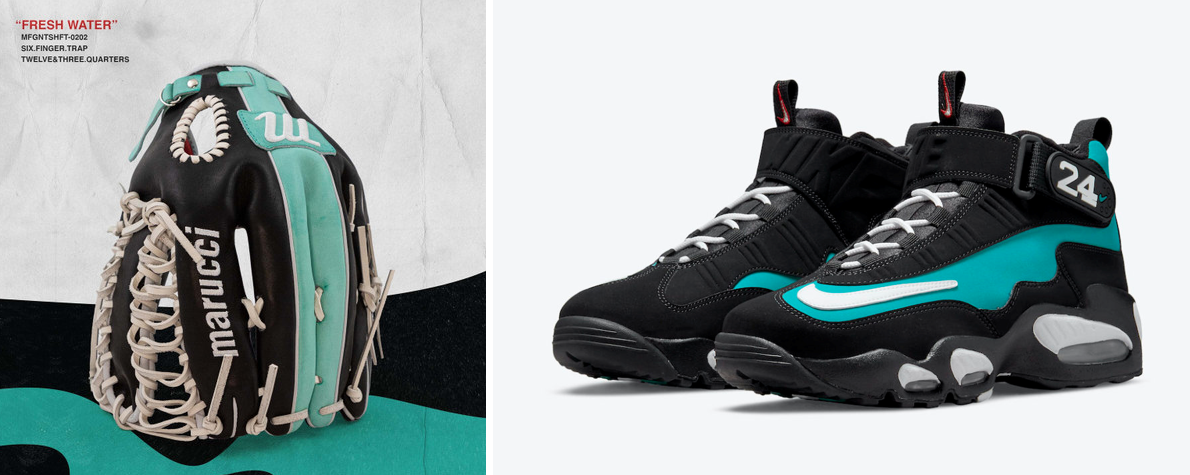
Contributed by Eric Walbridge
Contributed by Eric Walbridge
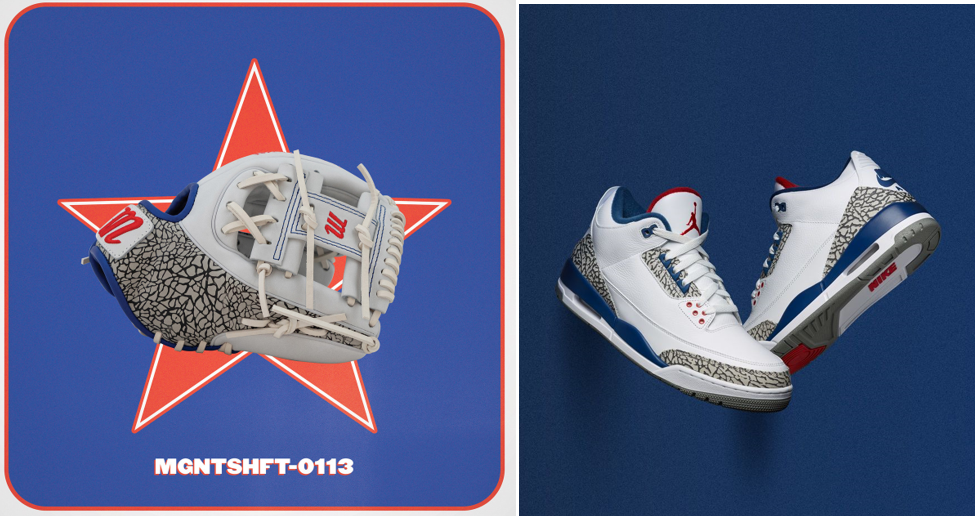
Contributed by Eric Walbridge
Contributed by Eric Walbridge
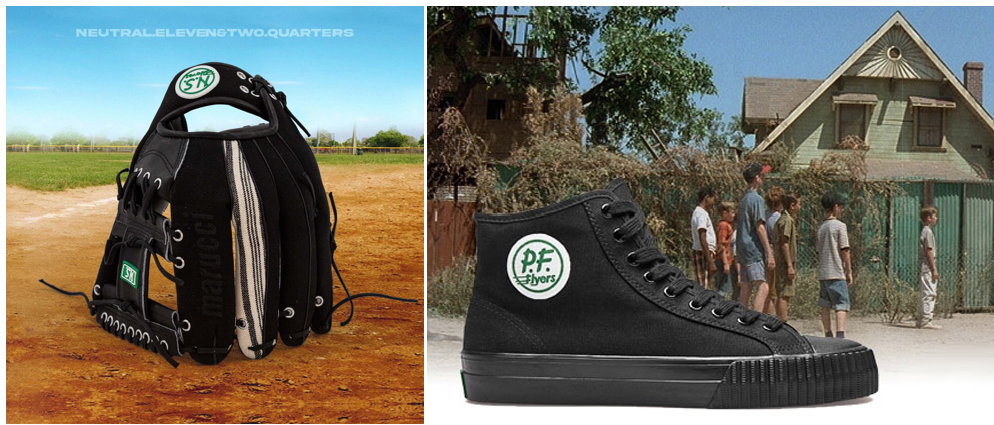
Contributed by Eric Walbridge
Contributed by Eric Walbridge
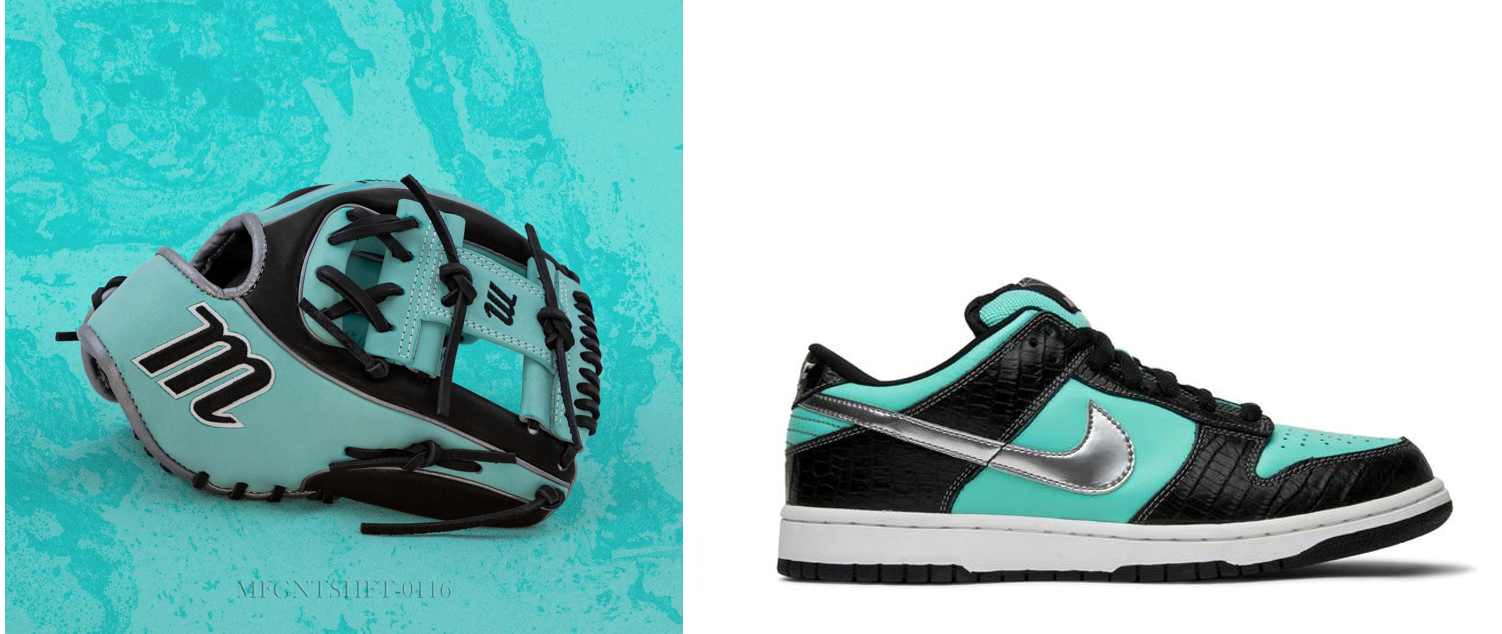
Contributed by Eric Walbridge
Contributed by Eric Walbridge

Contributed by Eric Walbridge
Contributed by Eric Walbridge
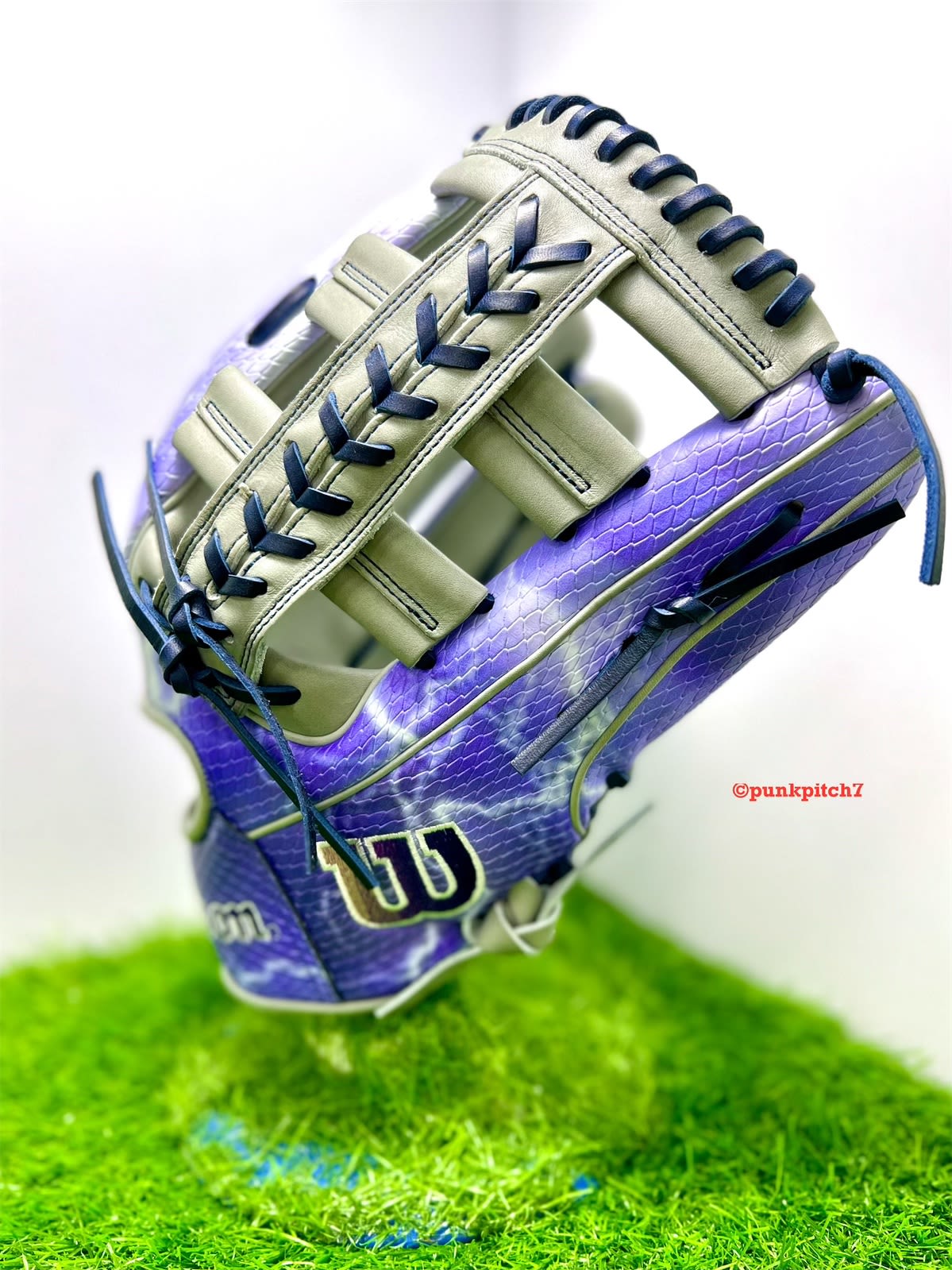
M.J. Melendez's mitt, contributed by Ryan Smith.
M.J. Melendez's mitt, contributed by Ryan Smith.
Wilson
Arguably the first traditional brand to expand aggressively in the custom glove game, Wilson has its name applied to gloves worn by players in the College World Series, MLB and even to the Savannah Bananas, an independent minor league known for its entertaining on-field antics and bright yellow uniforms.
Ryan Smith, the project manager for ball gloves for Wilson Sporting Goods, started his glove journey in the customization game.
His first love was basketball because of the style that the players had, especially Jordans. When he found out that he was too short to go far as a hooper, he turned to the diamond, but continued to follow everything happening in sneaker culture.
“I got into baseball and what got me into gloves, is gloves were kind of like sneakers, you could personalize it,” Smith said. “But when I was playing in high school and in college and stuff, gloves were black, and they were brown, and it wasn’t cool.”
Making gloves cool is what Smith started to do. In a time when Smith was looking for a career change, he moved to Arizona in pursuit of getting into real estate. The only problem was he did it in 2006, not the best time. In December of 2007, the Great Recession hit the U.S. and real estate was not the best industry to get into, so Smith pivoted.
He started working at Baum’s Sporting Goods Store, a small baseball specialty shop in Tempe, Arizona, and everything blossomed from there. Baum’s offered a service relacing and repairing gloves. Smith had done it for his friends during his playing days, so he picked up right where he left off.
“I started getting good at it, and then I started learning patterns and then I started customizing gloves for kids like doing different color laces and things,” Smith said. “Then I started talking with people from all the brands, because they would send people out to come see us.”
One of those people who would visit the shop was Michael Markovic, the current business manager for Wilson. Markovic would stop by to show off the new prototypes for the brand and Smith would critique them and test them in an adult baseball league where he played.
Originally loyal to Rawlings, Smith received his first Wilson and instantly fell in love.
“I took my Rawlings and got rid of it that night, because I had broken [the Wilson] in,” Smith said. “I was like, 'Ok, I believe in these guys,' and I was kinda all in and didn't realize that it would lead to where it has.”
Smith’s addition to the Wilson team changed the glove world forever. He took that same vision he had at Baum’s and applied it on a much larger scale.
Smith and Aso Shigaeki, Wilson’s ball glove master craftsman, now develop outlandish designs from tie-dye gloves to gloves that look like the American flag.
Even when Smith arrived at the company, the color choices were the same as they always have been, black, brown and a new groundbreaking color called gunmetal, which was a shiny gray. Aso and the rest of the team planned on using the gunmetal leather sparingly, accenting the gloves, but nothing crazy.
That was not what Smith had in mind. He wanted an entire glove made of the gunmetal leather.
At that moment, the brand changed.
“We’ve basically taken the shoe game and brought it to the ball glove business,” Smith said.
They now have limited product drops, special colorways and even collaborations on baseball mitts, and just like shoes, there is a market ready for it.
The new wave of funky and fun designs has materialized itself in Wilson’s limited drops. These serve as Smith’s opportunity to get wild with his ideas, design specialty gloves and really mine the color palette.
Wilson has been producing their Glove of the Month, or GOTM, since 2015, dropping limited edition gloves. These gloves can be gamers that are used by the actual players, or just fun colors that Smith likes, but his favorite of the bunch is a glove from 2016 called the Old Glory.
On glove day for the Tampa Bay Rays, Smith and his Wilson colleagues became a collective Santa Claus.
The summer Santas delivered 10 bags with 22 gloves in each for a whopping 220 gloves to distribute to the teams. Smith gave Alex Cobb his fresh new leather, and this particular glove day and the eventual GOTM carried special resonance because of it.
Cobb had two American flag patches sewn on his gloves, but that violated Wilson's official glove of the MLB policy. They had to be removed.
“I showed Alex and said, ‘Bro nice gloves, but I gotta cut these off,’” Smith said.
Cobb was disappointed but understood.
“He comes back a little bit later, and he was like, ‘Why do you have to cut him off?’” Smith said. “I'm like, ‘Well, you'll get fined.’ He's like, ‘Well, how much is the fine? Our fines go to charity. I don't care.’”
Cobb had a good point. What’s the worst thing that can happen, he gives additional money to charity? For Smith it meant more, he was early on in his career and the partnership that Wilson had with MLB was still fresh.
Today it would be a different story, but Smith stood firm with his stance.
“Then, after a while at that point it was like ‘I wonder why?’” Smith said.
After the glove extravaganza had concluded, Smith and his co-workers decided to watch practice. While there, they decided to Google Alex Cobb.
“We found out his brother is a captain in the U.S. Army, and I went from feeling bad already, that I had to cut the flags off, to like absolute shit,” Smith said. “Because now I knew why he had those flags on.”
Cobb noticed Smith on the fence and walked back over with another proposal.
“He’s like, 'Look I'll pay the fine. Will you make me another set with the flags on it?’” Smith said. “I said, ‘I’ll make a deal with you. So I don't get in trouble, I'm going to make you a completely different glove. MLB says you can't have flags on your glove, but they didn't say your glove couldn't be a flag. It's gonna have white, you'll never be able to use it in the game, but you can use it to warm it up in the bullpen, you can get photographed with it.'"
Cobb loved the idea, and it became the GOTM in July 2016. Not only did Wilson make the glove for Cobb, but they also made it for his brother and his entire unit in the Army.
Cobb’s connection to the flag on his glove is an aspect that gets overlooked. Sure, a player sporting an all-purple glove might be because he likes the color, but it could also be because it’s his mother’s favorite color, or something even deeper.
The GOTM gives Wilson a chance to release some of those special gloves and inspire the next generation of ball players. Kansas City Royals budding stars Bobby Witt Jr., and M.J. Melendez, are part of that generation, growing up and obsessing over GOTM.
“M.J. Melendez and Bobby Witt Jr. they came into our office, they started naming every single glove of the month,” Smith said. “They knew what month and year; I don't even know that. I couldn’t tell you what month and year that is because they all blend together for me. We’ve done 112 now.”
Melendez and Witt Jr. are just two of the new group of ballplayers that are focusing on making the game fun. When they met with Smith and Shigaeki to design their gloves for the season, the ideas came pouring out. Melendez especially had some far-out designs cooked up. With the help of Smith and Shigaeki, he will have two one-of-a-kind gloves for the 2023 season.
Melendez’s outfield glove looks like a lightning storm and a purple cobra hybrid. It features Wilson’s proprietary Super Snakeskin leather in a purple gradient with lighting strikes darting across the entire back of the glove.
For his catcher’s mitt, Melendez went a tad simpler. The palm is a light tan, and for the back he went back to the gradient, with a royal blue and white ombré.
Between the two gloves, it’s a fashion show every time the 24-year-old takes the field.
Wilson has come a long way since Smith first joined, and it has even become a family business of sorts. The company has been printing images and patterns on gloves for years now, and funnily enough, Smith’s wife Breanna Bader has been doing the graphic design work for it from the start.
Imprinting graphics on gloves marked a major step for Wilson, which took that step for the first time in the 2019 College World Series.
Smith and the rest of the team reached out to some custom cleat artists on Instagram, two of whom were Keenon Lopez @ikb20_customs and Jonathan Hrusovsky @jhru04.
Lopez had painted gloves and cleats for Athletics outfielder Tony Kemp, Dodger Mookie Betts, and other players. Being from Cleveland, Hrusovsky had dealt mostly with Guardians players, starting pitcher Mike Clevinger in particular. Wilson thought a collaboration would be the perfect opportunity to learn about the custom cleat game.
They tasked the group with painting specialty gloves for the CWS to be auctioned. The proceeds went to Kingdom Home, a charity co-founded by Tigers pitcher Matthew Boyd and his wife Ashley. The mission of the organization is to end child sex slavery by providing safe places to live for children who are at risk of entering the sex trade.
The artists could go in whatever direction they wanted. Lopez focused on the sights and scenes of the CWS, while Hrusovsky did something a little closer to his heart.
“I dedicated a glove to the men and women of the armed services,” Hrusovsky said. “Each finger was a like a panel for a branch of service, so like one was Coast Guard, Air Force and so on.”
Hrusovsky has family members in the military, so he likes to celebrate them every chance he gets.
“I love to honor the men and women and family members in the service,” Hrusovsky said.
The information and ideas that Smith got from Lopez and Hrusovsky acted as a catalyst for the printing that they do on gloves today.
“They're definitely doing some pretty cool things now that I didn't even know people were capable of doing,” Lopez said. “I've definitely noticed that the past two years, just seeing how far glove designs have come along.”
The designs have reached the point that coloring outside the lines is where Smith lives.
There's a lot of guys that do some fun stuff and a lot of things just come from talking to them,” Smith said.
One of those guys is former Cubs pitcher Alec Mills.
“He's where the paint splatter stuff came from because he came in, he had a pair of shoes on that he had just got, and he was with his wife, and they were coming in to design gloves,” Smith said. “I was like ‘Dude those are dope shoes. You want to make a glove that looks like that?’ He was like, ‘Can we?’ I was like, ‘I don't know, but let's try.’”
Just like that, a unique glove can come together. If you can imagine it, Smith can make it.
“It's all about showing style and personality as much as possible,” Smith said.
In 1954 Willie Mays’ glove may have been black or brown, but if he took the field in 2023, It's likely it would be a glove of a different color or colors.
